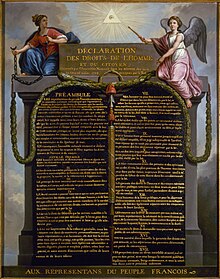Jean-Jacques-François Le Barbier
You can help expand this article with text translated from the corresponding article in French. (June 2016) Click [show] for important translation instructions.
|
Jean-Jacques-François Le Barbier | |
|---|---|
 Bust of Le Barbier (détail) | |
| Born | 11 November 1738 Rouen, France |
| Died | 7 May 1826 Paris, France |
| Nationality (legal) | French |
| Known for | Painter, illustrator, writer and philosopher |
| Notable work | Declaration of the Rights of Man and of the Citizen |
| Movement | Orientalist |
Jean-Jacques-François Le Barbier (born in Rouen on 11 November 1738 — died in Paris on 7 May 1826) was a writer, illustrator and painter of French history.
By 1780 he was an official painter of the King of France. [1]
He was the father of artist Élise Bruyère.
Work
His most famous work was a representation of the Declaration of the Rights of Man and of the Citizen made in 1789. He also designed the suite of tapestries of the four contintents (1790-91). [2]

-
Africa from a set of The Four Continents
-
Asia from a set of The Four Continents
-
Turkish Bathscape, illustration from the book, The Harem
-
The Hammam, date unknown
-
A Spartan Woman Giving a Shield to Her Son], before 1826
Select list of work
- Courage des femmes de Sparte se défendant contre les Messéniens, Musée du Louvre, Paris[3] ;
- Étude de femme en fureur, Musée Magnin de Dijon[4] ;
- Henri IV et Sully à Fontainebleau, Musée des beaux-arts de Pau ;
- Jupiter endormi sur le mont Ida, École nationale supérieure des beaux-arts de Paris ;
- La Grotte d’Égérie, Musée des beaux-arts de Rouen ;
- Le Vieux Mari, Musée Cantini de Marseille ;
- Les Amants surpris, Musée Cantini de Marseille ;
- Martyre de saint Sébastien, Musée des beaux-arts de Rouen ;
- Scène d’Amérique du Nord, Musée des beaux-arts de Rouen ;
- Un Canadien et sa femme pleurant sur le tombeau de leur enfant, Musée des beaux-arts de Rouen[5], tableau interprété en gravure par François Robert Ingouf[6];
- Le Courage héroïque du jeune Désilles, le 31 août 1790, à l'Affaire de Nancy, Vizille, musée de la Révolution française ;
- L'Apothéose de Rameau, Musée d'art et d'histoire de Toul ;
- Portrait de Madame Roland, Musée d'art de Toulon ;
- L'Apothéose de Lulli, Musée d'Art et d'histoire de Toul ;
- La Déclaration des droits de l'homme et du citoyen de 1789, Musée Carnavalet, Paris.
References
- ^ Peck, A. (ed.), Interwoven Globe: The Worldwide Textile Trade, 1500-1800, Yale University Press, 2013, p. 271
- ^ Peck, A. (ed.), Interwoven Globe: The Worldwide Textile Trade, 1500-1800, Yale University Press, 2013, p. 271
- ^ Base Joconde: Courage des femmes de Sparte se défendant contre les Messéniens, French Ministry of Culture. (in French)
- ^ Base Joconde: Étude de femme en fureur, French Ministry of Culture. (in French)
- ^ Base Joconde: Un Canadien et sa femme pleurant sur le tombeau de leur enfant, French Ministry of Culture. (in French)
- ^ Dictionnaire Bénézit, Gründ, 1999, François Robert Ingouf, tome 7, page 347.
External links
![]() Media related to Jean-Jacques-François Le Barbier at Wikimedia Commons
Media related to Jean-Jacques-François Le Barbier at Wikimedia Commons





![A Spartan Woman Giving a Shield to Her Son], before 1826](http://upload.wikimedia.org/wikipedia/commons/thumb/0/08/Jean-Jacques-Fran%C3%A7ois_Le_Barbier_-_A_Spartan_Woman_Giving_a_Shield_to_Her_Son.jpg/120px-Jean-Jacques-Fran%C3%A7ois_Le_Barbier_-_A_Spartan_Woman_Giving_a_Shield_to_Her_Son.jpg)